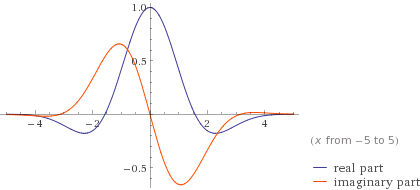Gabor Wavelet on:
[Wikipedia]
[Google]
[Amazon]
Gabor wavelets are

MATLAB code for 2D Gabor wavelets and Gabor feature extraction
Wavelets
wavelet
A wavelet is a wave-like oscillation with an amplitude that begins at zero, increases or decreases, and then returns to zero one or more times. Wavelets are termed a "brief oscillation". A taxonomy of wavelets has been established, based on the num ...
s invented by Dennis Gabor
Dennis Gabor ( ; hu, Gábor Dénes, ; 5 June 1900 – 9 February 1979) was a Hungarian-British electrical engineer and physicist, most notable for inventing holography, for which he later received the 1971 Nobel Prize in Physics. He obtaine ...
using complex functions constructed to serve as a basis for Fourier transform
A Fourier transform (FT) is a mathematical transform that decomposes functions into frequency components, which are represented by the output of the transform as a function of frequency. Most commonly functions of time or space are transformed, ...
s in information theory
Information theory is the scientific study of the quantification (science), quantification, computer data storage, storage, and telecommunication, communication of information. The field was originally established by the works of Harry Nyquist a ...
applications. They are very similar to Morlet wavelet
In mathematics, the Morlet wavelet (or Gabor wavelet)0).
The parameter \sigma in the Morlet wavelet allows trade between time and frequency resolutions. Conventionally, the restriction \sigma>5 is used to avoid problems with the Morlet wavelet a ...
s. They are also closely related to Gabor filters. The important property of the wavelet
A wavelet is a wave-like oscillation with an amplitude that begins at zero, increases or decreases, and then returns to zero one or more times. Wavelets are termed a "brief oscillation". A taxonomy of wavelets has been established, based on the num ...
is that it minimizes the product of its standard deviations in the time and frequency domain. Put another way, the uncertainty
Uncertainty refers to epistemic situations involving imperfect or unknown information. It applies to predictions of future events, to physical measurements that are already made, or to the unknown. Uncertainty arises in partially observable or ...
in information carried by this wavelet is minimized. However they have the downside of being non-orthogonal, so efficient decomposition into the basis is difficult. Since their inception, various applications have appeared, from image processing to analyzing neurons in the human visual system.
Minimal uncertainty property
The motivation for Gabor wavelets comes from finding some function which minimizes its standard deviation in the time and frequency domains. More formally, the variance in the position domain is: : where is the complex conjugate of and is the arithmetic mean, defined as: : The variance in thewave number
In the physical sciences, the wavenumber (also wave number or repetency) is the ''spatial frequency'' of a wave, measured in cycles per unit distance (ordinary wavenumber) or radians per unit distance (angular wavenumber). It is analogous to temp ...
domain is:
:
Where is the arithmetic mean of the Fourier Transform of , :
:
With these defined, the uncertainty is written as:
:
This quantity has been shown to have a lower bound of . The quantum mechanics view is to interpret as the uncertainty in position and as uncertainty in momentum. A function that has the lowest theoretically possible uncertainty bound is the Gabor Wavelet.
Equation
The equation of a 1-D Gabor wavelet is a Gaussian modulated by a complex exponential, described as follows: : As opposed to other functions commonly used as bases in Fourier Transforms such as and , Gabor wavelets have locality properties, meaning that as the distance from the center increases, the value of the function becomes exponentially suppressed. controls the rate of this exponential drop-off and controls the rate of modulation. It is also worth noting the Fourier transform of a Gabor wavelet, which is also a Gabor wavelet: : An example wavelet is given here:
Time-causal analogue of the Gabor wavelet
When processing temporal signals, data from the future cannot be accessed, which leads to problems if attempting to use Gabor functions for processing real-time signals that depend upon the temporal dimension. A time-causal analogue of the Gabor filter has been developed in based on replacing the Gaussian kernel in the Gabor function with a time-causal and time-recursive smoothing kernel referred to as the time-causal limit kernel. In this way, time-frequency analysis based on the resulting complex-valued extension of the time-causal limit kernel makes it possible to capture essentially similar transformations of a temporal signal as the Gabor wavelets can handle, and corresponding to the Heisenberg group, while carried out with strictly time-causal and time-recursive operations, see for further details.See also
*Gabor transform The Gabor transform, named after Dennis Gabor, is a special case of the short-time Fourier transform. It is used to determine the sinusoidal frequency and phase content of local sections of a signal as it changes over time. The function to be transf ...
* Gabor filter
In image processing, a Gabor filter, named after Dennis Gabor, is a linear filter used for texture analysis, which essentially means that it analyzes whether there is any specific frequency content in the image in specific directions in a localiz ...
* Morlet wavelet
In mathematics, the Morlet wavelet (or Gabor wavelet)0).
The parameter \sigma in the Morlet wavelet allows trade between time and frequency resolutions. Conventionally, the restriction \sigma>5 is used to avoid problems with the Morlet wavelet a ...
References
{{reflistExternal links
MATLAB code for 2D Gabor wavelets and Gabor feature extraction
Wavelets